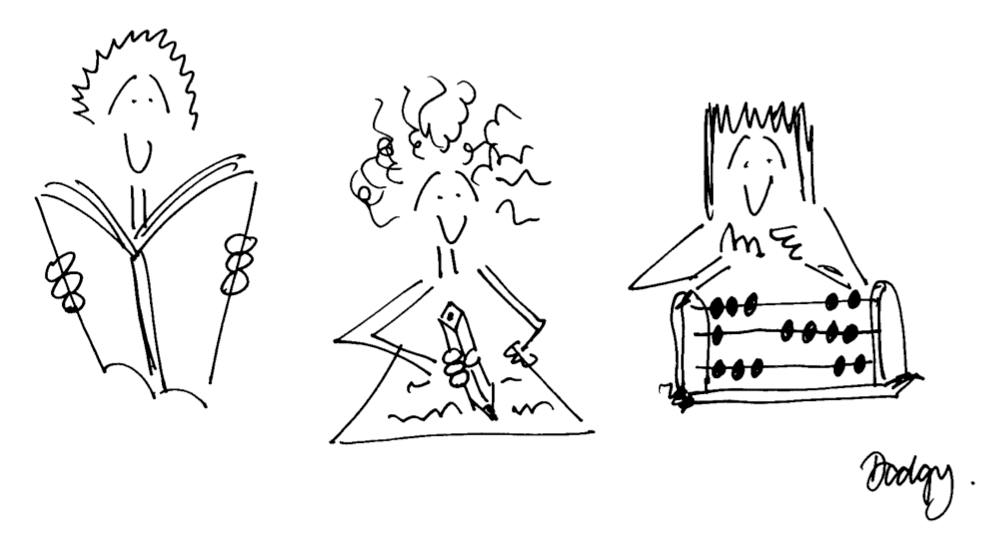
Back-in-the-day …
Back-in-the-day, before on-line submission and feedback, you could hide around the corner and watch students collect their marked assignments. The really fun bit was seeing how their eyes darted from the top of the page (where they checked their name) to the bottom (where they checked their grade), and how they skipped over all the helpful comments on the sheet you had taken hours to write, before they irreverently stuffed the assignment and mark-sheet into their bags! This process was born of that experience!

For about eight years now, one of us (Pete Higgins) has been experimenting with the feedback system on various courses, but in particular on the ‘Interpreting the Landscape’ course which is the first taken by postgraduate students newly enrolled on the MSc Outdoor Education and the MSc Outdoor Environmental Education programmes.
The process was devised to actively engage students in the feedback process, and to take responsibility for learning from it, and it includes a requirement, as an ungraded part of the assessment, that the students mark (but not grade) their own work, based on the PGT Common Marking Scheme. The process was originally based on submitting a separate ‘Word’ file to the Programme Secretary at the same time as the assignment was submitted electronically, but in the past three years it has been developed further and very effectively through the use of PebblePad (by Robert Chmielewski).
The feedback process
The key feature of the process is that the feedback is detached from the awarding of the grade. This is now provided separately and after the whole feedback process has run its course. The process:
- Students submit an assignment plan on PebblePad and then receive feedback and guidance (from the marker (PH) prior to submission.
- Students submit their assignment through Turnitin, and a self-assessment of their work (using the MSc common marking scheme) at the same time. They do this using PebblePad and are asked not to grade the work.
- The marker assesses the work and provides detailed in-text feedback and summative feedback (<5000 characters), but does not look at the student’s own self assessment. No grade is given at this stage.
- The students are then invited to a group study skills session where the marker provides an overview of the cohort’s performance in the assignment and general guidance on future submissions. Other programme staff are given the chance to comment on the content of this session and often attend.
- The students are then asked to reflect on this session, compare their self assessment with the marker’s, provide a brief analysis of any differences, and state three areas they will focus on to improve future work – this is done on through PebblePad using the original file they submitted.
- The marker then reviews all aspects of the students’ self-assessment, where appropriate provides further comment and releases the mark – again through PebblePad. This process is completed before the students submit their next assignment.
- The students are invited to discuss their assignment and marking/grading with the marker if they wish, and to argue the case if they feel the grade is too low – or too high!
- Finally, the students are encouraged to share their assignments – so they can learn both from the topics selected by their peers and their approach to writing. They are able to deposit a copy of their (un-marked) assignment on PebblePad in an area which other students can access. Only those students who have deposited their work have access to view others. The comments, mark sheets and grades are not visible to any reader.
Student feedback on the feedback process!
Feedback on the whole process has been gathered from each successive cohort and, where possible, improvements made. This has been gathered in several ways:
- through anonymous comments the students are invited to make on PebblePad at the final stage of the process;
- through EvaSys comments (note that the survey is not issued at the end of the course, but at the end of the whole marking and feedback process);
- through EUSA Award nominations and emails from students.
Student feedback has been virtually universally extremely positive, and many report that it has considerable benefits for subsequent assignments (other Programme staff do not use this process). For example, the EvaSys numerical evaluation could hardly have been more so (31 of 40 students completed the evaluation, 30 of those graded feedback as ‘5’ and one ‘4’). Whilst this is satisfying, the free-text comments are perhaps more valuable, and these were detailed and universally positive.
This was true of the end of process PebblePad comments too, though many were more elaborate, for example appreciating the value of the process for mature students returning to study, and at PG Level. One detailed comment (from a EUSA nomination) effectively captures the value students place on the process:
As it is the first course of our programme, many students feel unsure about this very first assignment … However, PH managed to both ease students’ worries, encourage them to take risks and challenge themselves with the assignment, give formative feedback on the assignment planning process, and to provide the most extensive feedback I have yet received for any assessment during my entire academic career. Before the grades for the assignment were released, each student was given in-depth written comments on their performance, and asked to compare this to a self-evaluation sheet that was filled out when handing in the assignment. A group feedback session was also held to go over some general points from the assessment. Though this process might seem arduous to some (and I have hardly done it justice here), it really allowed us to reflect on our learning and the writing process itself, and provided very helpful pointers for how to approach assignments in the future. If every professor were to provide such valuable assessment feedback, the assessment processes here would be immensely more useful, as the students’ actual learning (and not just their grades) becomes the centre of attention.
Whilst there will no doubt be readers who will be aghast that this appears to be an awful lot of work, it is important to point out that students often comment on the positive effects on future assignments, making marking these much more straightforward – so saving staff time. The staff team are equally positive about this!
The use of PebblePad in the process was the theme of a recent conference presentation at the 2016 International Conference of Education, Research and Innovation. The Students Feedback on Feedback presentation provides an explanation of the process for the students, and also summarises some aspects of feedback.





Dear Peter and Robert,
Thank you for an interesting piece. If I understood this correctly, the assessment described was the first assessment in the programme. The appeal of doing the assessment in this way is not only instrumentalist (e.g. better learning, understanding of assessment criteria, better marks in future assignments, etc.), but is also -as I saw it- the appeal to students of feeling welcomed, supported, and recognised (by valuing the self-assessment) as part of a learning community. Such an approach to a first assessment in a programme can be very fruitful in terms of setting the learning scene, and in placing learning within a community. These ‘higher-order’ rewards are well worth the effort.
Best wishes